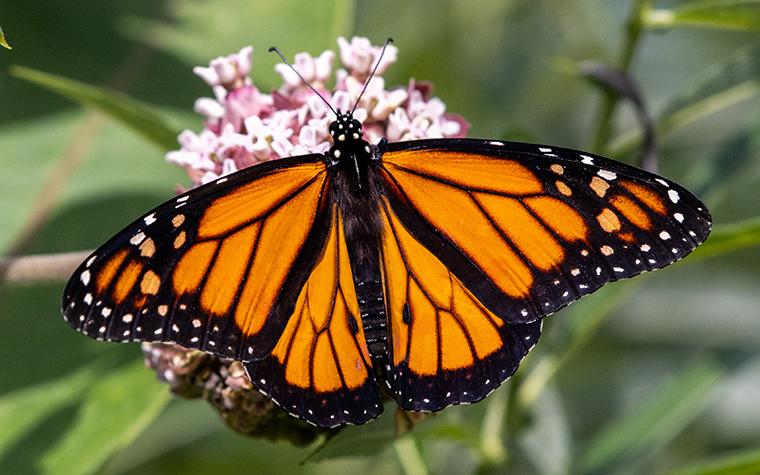MU Extension partners with Highway 13 Butterfly Trail group.
COLUMBIA, Mo. – The Highway 13 Butterfly Coalition is working to make Missouri a fueling station for pollinators as they migrate between Canada and Mexico.
The coalition began as the dream of a small group of dedicated people working to improve pollinator habitat and promote ecotourism along Missouri Highway, says University of Missouri and Lincoln University Extension urban entomologist Emily Althoff.
The grassroots group began its work in 2017 when members of the Hamilton Community Alliance approached the City of Hamilton about developing a 10-acre parcel of city-owned property as a butterfly park. Many of the volunteers were retirees of nonprofit groups or governmental agencies.
The dream grew to encompass a north-to-south trail along Highway 13 through western Missouri when the Department of Conservation began working with the Highway 13 Corridor Coalition.
The trail would serve as an important connector for eastern monarch butterflies en route from Canada to Mexico, where they overwinter. They migrate north in spring, usually traveling in groups and often stopping at the same places, says Althoff.
The 26-mile-wide trail would extend 292 miles, stretching from Hamilton to Branson. With two of Missouri’s most popular tourist destinations bookending the trail, supporters say it would provide economic opportunities for businesses and towns along the way, tapping into a growing conservation trend to support ecological efforts and boost the state’s economy through ecotourism.
Hamilton, population 1,800, attracts more than 100,000 visitors and 100 tour buses annually to 12 quilt shops and other attractions related to the Missouri Star Quilt Co. The butterfly park is expected to draw another 25,000 visitors annually, adding to the state’s $19.9 billion tourism industry.
The J.C. Penney Museum and Boyhood Home, also in Hamilton, honors the retail giant. On the other end of the state, Branson is one of the country’s largest tourist hot spots, drawing more than 10 million visitors annually.
Volunteers began enlisting the cooperation of state agencies, educational institutions and nonprofit groups to create pollinator plots in the 12 counties along the route. Western Missouri’s abundance of pollinator-friendly flowers, shrubs, plants and trees will provide food, water, shelter and breeding grounds for pollinators making the annual trek, says Althoff.
Education plays a key part in the efforts, she says. That’s where MU Extension will lend its expertise, drawing on educators with experience in entomology, horticulture, agronomy and business development to lead biodiversity assessments and habitat studies. They also will play key roles in creating educational displays.
The project also will provide aesthetic opportunities for travelers, including murals, statues and “Barn Butterflies” – designs on barns like “barn quilts” throughout rural Missouri. Plans include “butterfly stops” at Little Otter Creek Reservoir Project near Hamilton, Springfield Botanical Gardens and the Butterfly Palace in Branson.
According to a 2021 report from the Missouri Department of Conservation, conservation spending contributes more than $507 million annually to Missouri’s economy. The coalition sees an opportunity to build momentum for the project by promoting “Monarch Mania,” although the trail will benefit all pollinators, including bees and hummingbirds.
“I am excited to work on the Butterfly Trail, which will entail three E’s that are important to me: Environment, Education and Economy,” Althoff says. “By adding the fourth E, Extension, the University of Missouri can extend its educational and research resources from campus to county to showcase the great state of Missouri.”
Partners include MU Extension, Missouri Department of Economic Development, Missouri Conservation Department, Bee and Butterfly Habitat Fund, Allstate Consulting, National Park Service, Missouri Community Betterment, U.S. Fish and Wildlife Service, Missouri Department of Transportation, U.S. Department of Agriculture, Smithsonian Institution and Union Sportsman’s Association, according to a project summary report. The Missouri Prairie Foundation, which owns and operates five native prairie grass sites within the corridor, also has an important role promoting the state’s environmental contributions to increasing pollinator habitats.
Communities along the route include Eagleville, Bethany, Coffee, Jameson, Gallatin, Hamilton, Kingston, Polo, Richmond, Harrietta, Lexington, Higginsville, Warrensburg, Clinton, Osceola, Humansville, Bolivar, Brighton, Springfield, Nixa, Spokane, Reads Spring, Branson, Stone Ridge and Blue Eagle.
Learn more about the Highway 13 Butterfly Trail.
Photo
Monarch butterfly
Photo by Abbie Nell Lankitus, University of Missouri.
